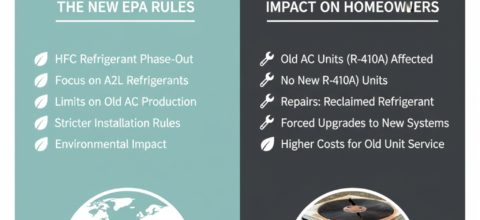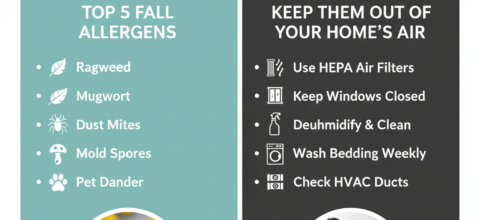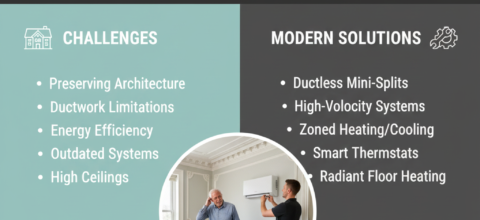Toms River Pine Barrens Are Beautiful, But Is All That Pollen Now Living in Your Vents?
The Pine Barrens are one of New Jersey’s natural treasures. Stretching across Ocean, Burlington, Atlantic, and Camden counties, this ecosystem offers hiking trails and wildlife viewing just minutes from home. For Toms River residents, the Pinelands are a source of local pride.
But every spring, things get messy. Late April through May brings what locals know all too well: yellow dust everywhere. Cars, patio furniture, driveways, windowsills, all covered in fine powder from millions of Pitch Pine trees releasing pollen.
Your HVAC System Breathes In All That Pollen
Can pollen get trapped in air vents? Yes, absolutely. Your HVAC system works like your home’s lungs, constantly pulling in outdoor air and pushing it through every room. During pollen season, that means sucking in allergens every time your heating or cooling runs.
The pollen count in Toms River NJ gets high during these weeks. You can track daily numbers, but what really matters is what happens after those particles enter your ductwork. Outside, wind and rain clear the air eventually. Inside your vents, pollen settles and stays put.
When Will Pine Pollen Season in Toms River End?
Outdoors, the pine pollen season usually fades within a few weeks. Indoor contamination is different. Your air ducts are dark and sheltered, letting pollen settle in and stay for months. Every time your system kicks on, it stirs up what’s sitting there and blows it through your house again.
Toms River pollen count may drop as summer approaches, but allergy symptoms don’t. You’ve cleaned surfaces, changed bedding, kept windows closed. Still sneezing and congested? That’s often a sign the problem isn’t the air outside anymore. It’s what’s been building up inside your ducts.
Your vents don’t just trap pine pollen. Once inside, that yellow dust mixes with everything else—pet dander, dust mites, mold spores, regular household dust, and every heating or cooling cycle sends that mix back through your rooms.
How to Tell If Your Ductwork Is Contaminated
Several signs point to contaminated ductwork. Visible dust around supply vents means buildup inside the system. A musty smell when the HVAC runs often means organic material trapped in there. Worse symptoms at home compared to outdoors is another red flag.
Symptoms might spike right after the system turns on. Air movement kicks up settled particles and sends them into your breathing space. Some people need to dust constantly or find debris reappearing on surfaces days after cleaning, clear signs that air from your ducts is carrying dust back into the room.
Where Pollen Goes Once It’s Inside
Particles enter through return vents and get pulled toward the air handler. Some get caught in filters, many don’t. They settle on duct surfaces. The bends, turns, and connections in ductwork create spots where material piles up.
Our humid coastal climate means temperature shifts and moisture inside ducts can let organic materials break down or support mold growth. Simple pollen contamination can turn into a bigger air quality problem over time. If you’re wondering how long pine pollen stays in the air, the answer inside your ducts is: way too long.
Cleaning Your Air Starts with Clean Ducts
Improving air quality in home spaces means addressing the source, not just treating symptoms. Air purifiers and filters help, but they can’t remove what’s already embedded in your ductwork. The Pitch Pine pollen that created that yellow coating outside has worked its way deep into your system.
Good indoor air quality depends on clean air pathways. When ducts contain built-up allergens, even quality filters struggle to keep up. The system keeps reintroducing irritants faster than filters can catch them. Your HVAC ends up working against you instead of helping.
When to Deal with Seasonal Buildup
Pollen in Toms River follows patterns. Spring brings the big pine surge. Fall has ragweed, the most common trigger for lingering allergy symptoms in this area. Summer brings various grasses. Each season adds more to your ductwork.
Acting after major pollen events helps prevent long-term buildup. Late spring, after the pine pollen dump, is a good time to address what’s accumulated. This removes the seasonal surge before it settles deeper or combines with other stuff.
What It Takes to Get Years of Build-Up Out of Your Ducts
Duct cleaning goes after the buildup you can’t reach with a vacuum or duster. It covers your entire ventilation system, not just the vents you see on your walls and ceiling.
The technician starts by looking through your ducts to see where debris has piled up. Then they use equipment designed to loosen and pull out dust, pollen, and other stuff that’s been sitting there. Strong vacuums with HEPA filters grab these particles so they don’t blow back into your rooms.
Most services also clean your condenser coils, since outdoor debris can collect there and mess with your airflow.
Every Home Has Different Air Quality Needs
Location matters. Proximity to the Pine Barrens increases pollen exposure. Pets add dander. Older ductwork may have more joints where material collects. Recent construction creates dust that gets into the system.
Knowing what drives your air quality concerns helps you figure out solutions. If seasonal allergies dominate, timing cleaning around major pollen events makes sense. Year-round issues might mean you need to look at humidity control or better filtration.
How Often to Clean Your Ducts?
Most Toms River homeowners benefit from cleaning every three to five years. Some situations call for it sooner. Visible mold, pest problems, or water damage need immediate attention. Recent renovations generate dust that should be removed before it circulates for years.
Families with severe allergies or breathing issues often schedule more regular cleaning. After major storms or during intense pollen seasons, extra cleaning can help manage indoor allergen levels. Still wondering if you need it? These 5 signs usually mean it’s time.
Why Local Knowledge Matters
Living in Ocean County means dealing with unique air challenges. Pine pollen, coastal humidity, and older ventilation setups all affect how clean air moves through a home.
Understanding those patterns helps homeowners make better choices about when to schedule cleaning or inspections. Homes near wooded areas or closer to the bay might collect different types of debris inside the ducts. Local knowledge isn’t just about geography, it’s about knowing how this region’s climate, housing styles, and pollen cycles work together to shape your air quality.
Take Control of What Happens Indoors
You can’t stop pollen season in Toms River or prevent the Pine Barrens from releasing their annual yellow dust. But you can manage what happens inside your home. Duct cleaning removes built-up allergens that keep symptoms active long after outdoor conditions improve.
The process helps your HVAC system do what it’s meant to do, circulate clean, conditioned air through your living spaces. Instead of redistributing contaminants, it supports a healthier indoor environment for everyone in the home.









